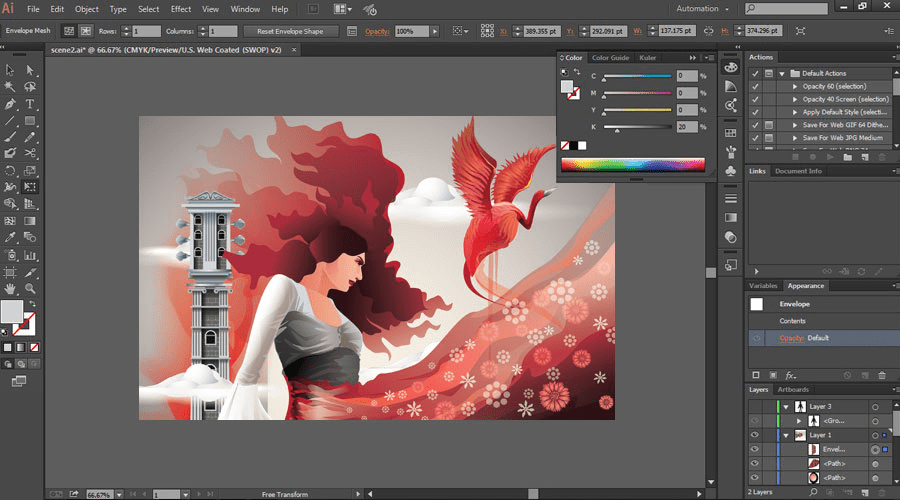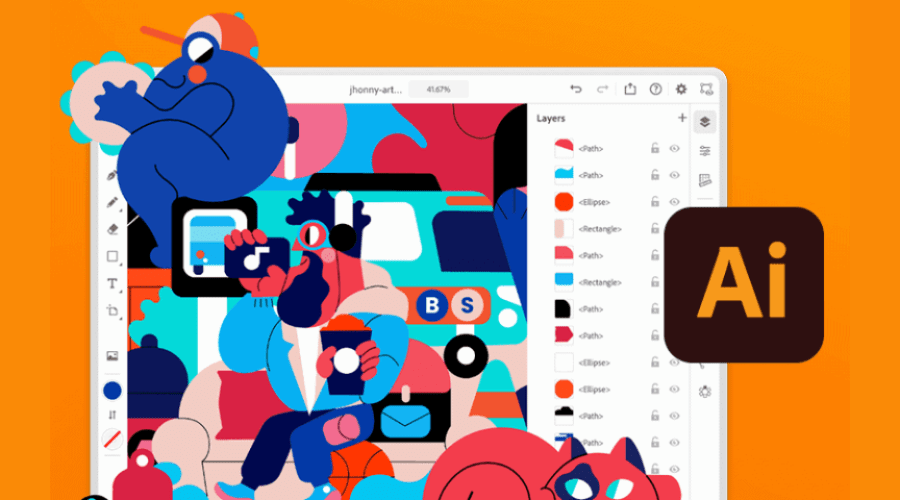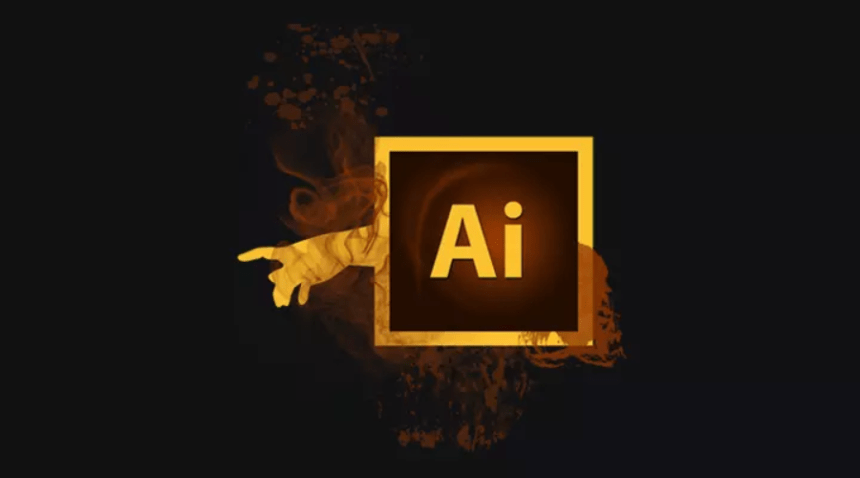If you are seeking Adobe Illustrator features, it’s likely you are already cognizant of its utility and how it optimises your design and graphic creation workflow. To give a glimpse though, Illustrator provides you with the most basic features to the more advanced ones to give your creativity the right pathway. It comes with its own pool of features that help you create genius artworks. Let’s take a look at some of the best features and how you can employ them to ease your design process.
Key Adobe Illustrator Features for Designers
Vector Drawing and Editing Tools-
These features empower you to sketch and modify vector paths, forms, and curves utilising anchor points and bezier handles. They afford mastery over the visual aspect and functionality of vector entities, facilitating the amalgamation, subtraction, and metamorphosis of these entities into intricate illustrations or designs. With these utilities, you can generate scalable graphics that uphold their integrity at all resolutions, rendering them optimal for logos, icons, and other graphical elements employed in print or digital media. Check out Adobe Illustrator now!
- Pen Tool: Create accurate vector paths and shapes by selecting and dragging anchor points.
- Shape Tools: Generate fundamental geometric forms such as rectangles, ellipses, polygons, and stars.
- Pencil Tool: Sketch unrestricted paths that can be transformed into vector paths or utilised as calligraphic brushes.
- Pathfinder: Amalgamation, deduction, division, and manipulation of vector paths in diverse manners.
Typography and Text Handling
These Adobe Illustrator features permit you to add, edit, and style text with detailed oversight over typography elements such as font family, size, leading, kerning, and more. You can generate dynamic text effects by positioning text along curves or within shapes, and traverse creative typographic layouts using area type tools.
- Type Tool: Allows you to add and edit text with options for adjusting font, size, leading, kerning, and more.
- Text on Path: This enables you to place text along a vector path, with options to adjust orientation and spacing.
- Area Type Tools: Allow you to create text within a specific area or bounding box.
Read more: Try Adobe After Effects Free Trial To Enhance Your Creativity Today!
Colour and Swatches

These Adobe Illustrator features dispense a stack of colour models and pickers to select and apply colours to your artwork to the dot. The swatch panels allow you to create and manage reusable colour swatches for colour usage on your designs.
- Colour Panels: Provide various colour models- RGB, CMYK, HSB, etc. and colour pickers for selecting and applying colours.
- Swatch Panels: Create and manage colour swatches for consistent colour usage across your designs.
- Global Color Editing: Edit and update colours globally across your artwork.
Brushes and Patterns
The brush libraries in Adobe Illustrator Features offer calligraphic, artistic, and pattern brushes, to add accurate strokes and textures. The Pattern Brush Tool enables you to create custom, repeating patterns along vector paths, while the Pattern Options lets you design and edit your own pattern swatches.
- Brush Libraries: Calligraphic brushes, art brushes, and pattern brushes for detailed strokes.
- Pattern Brush Tool: Create repeating patterns along a vector path.
- Pattern Options: Create and edit pattern swatches, including brick patterns, hex patterns, and more.
Layers and Artboards
Layers allow you to separate and group different elements, enabling precise editing and visibility control. Artboards provide multiple canvas surfaces within a single document to create multi page layouts, responsive designs, or breaking larger projects into manageable sections.
- Layers Panel: Organise and manage different elements of your artwork on separate layers.
- Artboards: Create multiple design surfaces within a single document, useful for web design, UI design, and print layouts.
Read more about: Edit Photos Like A Pro Using Adobe Lightroom Mobile Editing Feature
20 Ways to Utilise the Adobe Illustrator Features

- Logo Design: Create distinctive and adaptable logos by utilising vector shapes and pathways. Illustrator provides meticulous command over each element, guaranteeing that your logo maintains its clarity regardless of its scale.
- Icon Creation: Develop visually polished and uniform icons for websites, applications, or presentations with Adobe Illustrator features. Use fundamental geometric forms and the Pathfinder panel to merge and transform them for flawless icon design.
- Artistic vision through illustrations and cartoons: Create intricate sketches or whimsical cartoons with a diverse range of tools such as the Pen Tool and brushes.
- Typography & Text Effects: Generate personalised typography or enhance the visual appeal of current text with Adobe Illustrator features. Explore the use of warp effects, text along a path, and gradients to achieve a distinctive visual appearance.
- Pattern Design: Create intricate designs for fabrics, wallpapers, or backdrops using the art of pattern making. The pattern tools in Illustrator facilitate the effortless generation and replication of elaborate designs.
- Diagrams and Infographics: Utilise diagrams and infographics to graphically convey intricate information in a concise and well-structured manner. Employ geometric forms, graphical representations, and symbolic images to convey information in a clear and impactful manner.
- Create intricate floor plans or illustrated maps for use in presentations, brochures, or websites. Employ careful scale and rulers to provide an exact and precise portrayal.
-
Product package Design: Design a visually appealing package design for your items. Utilise vector graphics, textual elements, and photographs in order to create aesthetically pleasing packaging with a professional appearance.
-
Poster Designs: Create compelling signs or posters by utilising prominent typography and captivating images. Employ a range of typefaces, hues, and design strategies to provide the greatest possible visual effect.
-
Mockups & Prototypes: Generate lifelike representations of your ideas on tangible items such as t-shirts, mugs, or phones. Demonstrate your thoughts in a concrete manner.
-
Website wireframes prior to coding- Utilise fundamental geometric forms and instruments to strategize the layout and interaction design of the user interface and user experience.
-
Storyboards and comic strips: Create captivating storyboards or comic strips for animation, videos, or presentations. Illustrator enables the creation of sequences with many panels.
-
T-Shirt Design: Create personalised t-shirts using innovative visuals and text. Employ vector graphics for clear and easily adjustable printing.
-
Photo Editing & Manipulation: Improve the quality of images or apply artistic alterations to them. Utilise the Pen Tool to separate objects, modify colour settings, and incorporate vector components into pre-existing pictures.
-
Colour Palettes & Swatches: Generate personalised colour palettes or utilise pre-established ones to maintain design uniformity. Utilise the Swatches window to arrange and oversee your colour selections.
-
Convert Raster Images to Vector Graphics: Transform a raster image, such as a photograph, into a vector graphic to facilitate effortless modification and scaling. Utilise the Image Trace functionality to achieve a precise and polished translation of raster images into vector format.
-
Vector Tracing & Lettering: Convert pre-existing logos or lettering into vector format suitable for digital applications. This enables accurate modification and resizing of the artwork.
-
3D Extrude & Bevel Effects: Enhance your designs by including 3D Extrude & Bevel effects, which will add depth and dimension to your artwork. Generate lifelike 3D forms based on your 2D illustrations. Try it now!
-
Live Shapes and Blend Modes: Engage in the process of combining different forms and colours to get distinctive and visually appealing outcomes.
-
Utilise variable fonts and OpenType technologies to achieve advanced typographic control. Modify the weight, width, and other attributes of the typeface to create expressive typography.
Also read: From Concept to Creation, Use Adobe XD UI/UX Design Templates
Conclusion
Adobe Illustrator features contribute to creating the most basic and even the most advanced graphics for all your digital requirements. It does take a bit of expertise and practice to get a stronghold at its many attributes, but the entire process in itself is extremely yielding and can do wonders for your career. Download Adobe Illustrator from the Adobe official website now and start creating designs that matter!
For more information on Adobe Illustrator features, visit TheWebHunting.















